South Side Auditorium
1201-05 3rd Street So.
Minneapolis
The South Side Auditorium was located in a building variously known as 311 12th Ave. So., or more formally by the City as 1201-05 3rd Street So. in Minneapolis. It was usually just described by its location at the intersection of 3rd Street and 12th Ave., and I thank Jeff Neuberger for helping me sort out which corner that was.
THE BUILDING
This was one of the City’s older buildings, built in 1888 at a cost of $45,000 (one account said $52,000) by the Normanna Corporation. A stipulation written into the Articles of Incorporation of Normanna was that to be a stockholder, one must be a Norwegian by nativity or lineage, or shall have been a Norwegian citizen, or speak the Norwegian language, and must be a resident of Minneapolis or vicinity. (Minneapolis Tribune, January 31, 1886)
The footprint of the building was 66 ft. along Third Street x 118 ft. along 12th Ave. It was made of brick and stone, four stories high with a basement. There were to be stores on the Third Street frontage, and a gymnasium for the “Norwegian Turner Society.” The Hall was located on the second and third floor, and was to be one of the “principal features of the edifice.” On the fourth floor were the club rooms, reserved for the members of the Normanna Society who had contributed to the building fund. These rooms included a club parlor, reading room, dining room, stage, storeroom, and stage loft. The cornerstone was laid on August 18, 1888, with the customary speeches and a parade. (Minneapolis Tribune, August 19, 1888)

In 1894 the building was foreclosed on by the Northwestern Mutual Life Insurance Co. of Milwaukee, which held a $40,000 mortgage.
In 1908, NMLI sold it to the American Bank Protection Company for $25,000. The company made devices to prevent banks from being robbed. At that time, the name of the company was changed to O.B. McClintock, but was still referred to by its previous name.
Although it was called an auditorium, and it did host meetings, speeches, boxing matches, etc., it appears that most of its activity was more of that of a ballroom. And the owners of the venue were very liberal when it came to who they rented it to. In particular, it was one of very few venues that the black community could rent for their dances, which was important since they were not welcome at downtown nightclubs.
PAPER DRESS DANCE
The first event mentioned at the South Side Auditorium (SSA) in the Minneapolis Tribune was a “Paper Dress Ball,” in which all the women would be wearing dresses made of the colored newspaper supplements of the Tribune – yellow, red, pink, and green. The dance was given by the South Side Dancing academy, the “high life” department of the the Twin City Colored Waiters’ union. The group was described as the “Dusky 400,” and their leader and master of ceremonies for the dance was George Washington Tyler. The feature of the affair was to be the introduction by Prof. A.C. Irvin of the latest dances from gay Paree, including the Imperial Gavotte, the Delagrade Flirtation Waltz, and the Cream City Minuet. “‘Law, you ought to see the way that boy takes with the girls,’ says George Washington Tyler.” (Minneapolis Tribune, November 29, 1909)
THE SWITCHMEN’S DANCE
In 1910 the Railroad Switchmen were on strike, and had used the SSA as a meeting place. Regardless of these tensions, the Switchmen’s Dance at the SSA on February 21, 1910, was a big success. Nearly 5,000 tickets were sold, and attendance was the largest ever at the SSA. Labor leaders were in attendance. (Minneapolis Tribune, February 27, 1910)
STROM AND BRUNZELL
According to an anniversary article from 1928, Hans Strom and Herbert Brunzell (both spelled many different ways in the paper) became the proprietors of the SSA on April 15, 1911. (Minneapolis Star, April 14, 1928)
JAIL BAIT PART I
Policewoman Miss Emilie Glorieaux pulled four underage girls, no older than 16, from a dance at the SSA, and stashed them at the Central police station as witnesses against the men in charge of the dance: Hans Strom, Herbert Brunzell, and Henry Grafstrom. Strom was fined $25. (Minneapolis Tribune, September 11, 1911)
JAIL BAIT PART 2
An article from 1912 tells us that Hans Strom was the proprietor of the SSA, and that he was fined in municipal court for allowing minors in the hall. It was the second fine imposed on Strom in six months, and the judge doubled the amount of the fine to $50. Policewoman Miss Emilie Glorieaux told the judge that of 500 or 600 dancers there one Sunday night, fully 100 of them looked to be under age. She arrested three girls. Strom pleaded guilty. Arrested with Strom was Herbert Brinzell (sic), but he was dismissed, as Strom testified that Brinzell no longer had an interest in the hall. This was probably a lie. (Minneapolis Tribune, March 15, 1912)
EJECTED TANGOISTS GET $15 WORTH OF REVENGE
By 1915 the SSA was managed by Strong and Brunzell. This couldn’t be a variation of Strom and Brinzell from the story above, could it? Anyway, in this story, two men became boisterous while tangoing about the floor and were ejected from the hall. They returned and demanded the return of their entrance fee. The ticket seller refused, but one of them stuck his arm through the window, scooped up $15 (the receipts for the night), and they both fled. (Minneapolis Tribune, June 28, 1915)
In February 1919, Little Johnnie’s full orchestra provided the music for dancing.
On October 10, 1920, fire broke out on the fourth floor, while about 200 dancers were doing the one-step below. A sprinkler system went on, the fire was quickly subdued, and the customers went home wet but safe. The American Bank Protection Co. had its paint shop above the hall, and incurred about $5,000 in damages. Evacuation of the building went on “without hysteria.” (Minneapolis Tribune, October 10, 1920)
NORTHWEST BULLETIN
There were many ads for dances in the Northwestern Bulletin in 1922 and 1923. The Northwestern Bulletin was an African-American weekly newspaper that was published out of St. Paul from 1922 to 1925. I have collected several of these ads and will post some of the most interesting.
For the Entertainers Spring Ball below, music was provided by Moore’s Jazz Orchestra. William W. (Bill) Moore was a bandleader who was very busy in the 1920s, and could assemble an orchestra of any size for any occasion. From the ads I’ve seen, he must have been the top bandleader of the time. At this dance, the band was joined by Louis Sklar, “Famous Saxophone and Clarinet Player.”
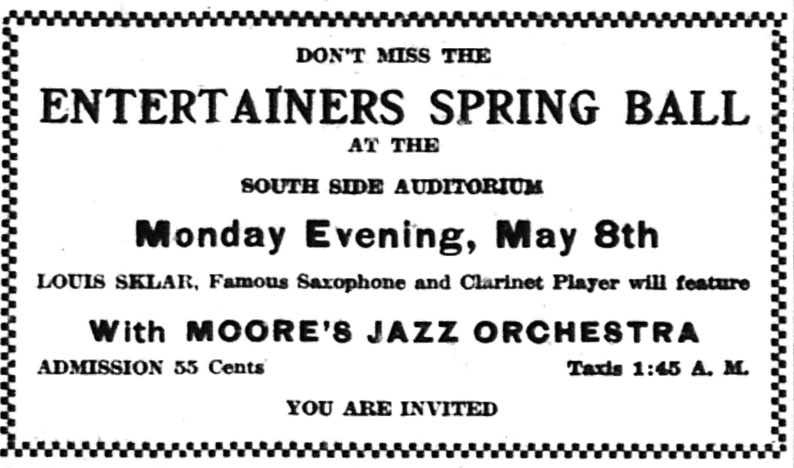
BELLHOP DANCE
These were fine times when all of the trades got together and had annual dances, customers be hanged. And such was the case with the bellhops of Minneapolis on August 16, 1922, when they held their annual ball at the SSA. A colorfully-written article suggests some new dances for the bellhops to learn. And this:
Guests at the hotels will have to wait on themselves tonight – and if the service is satisfactory give themselves a tip. No bellhop will dash into the lobby to confiscate the baggage of the incoming traveler or lead him up to his sixth floor room or answer his petulant punches of the call bell. The magii (sic) of the hostelries will be busy tripping the light fantastic toe elsewhere.
(Minneapolis Tribune, August 16, 1922)
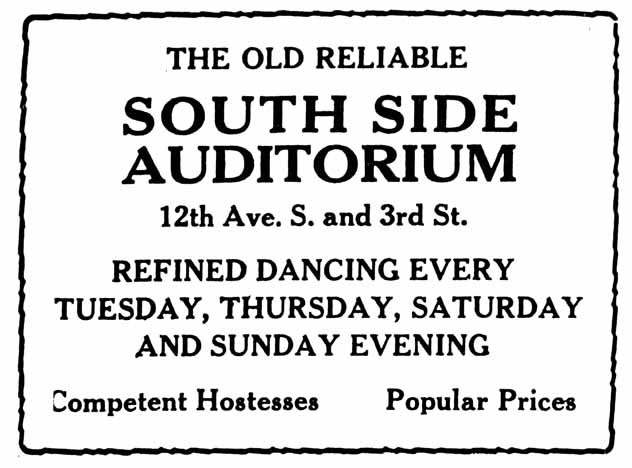
An article in the Northwestern Bulletin dated September 8, 1923, squelched a rumor that the venue would no longer be made available for dances by and for the black community. Bandleader Bill Moore “got in immediate touch with the management and convinced them that the major portion of the Twin Cities people were not of the rowdy element. Re-assured of the proper conduct, the manager again promised the hall under proper conduct.”
THE CLEF CLUB
The Clef Club was a nightclub located in the Kistler Bulding on Sixth Ave. No. They would schedule many dances at the SSA, many with themes or around the holidays.
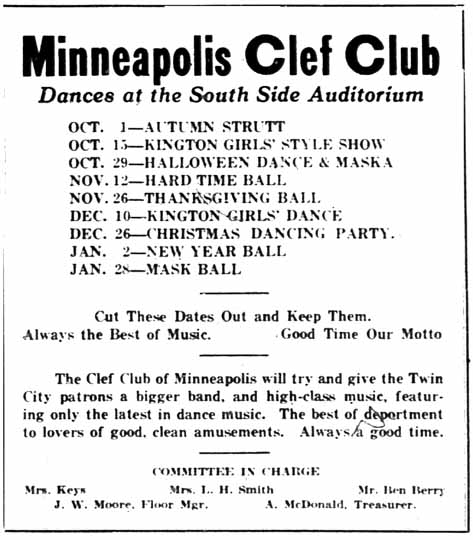
JAZZ HOUNDS
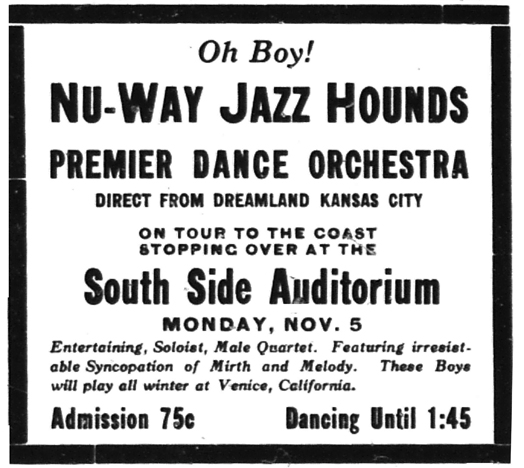
TURKEY TROT
This Thanksgiving dance – Turkey Trot and Sweet Potato Roll – introduced the novelty dance “The Balloon Strut” and gave away two live turkeys! It was a Clef Club production, with Bill Moore’s Town Talk Band on for entertainment.
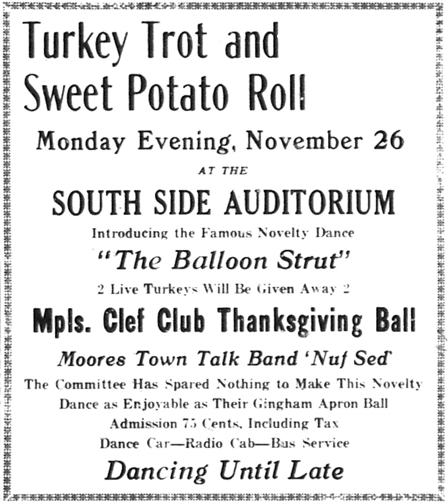
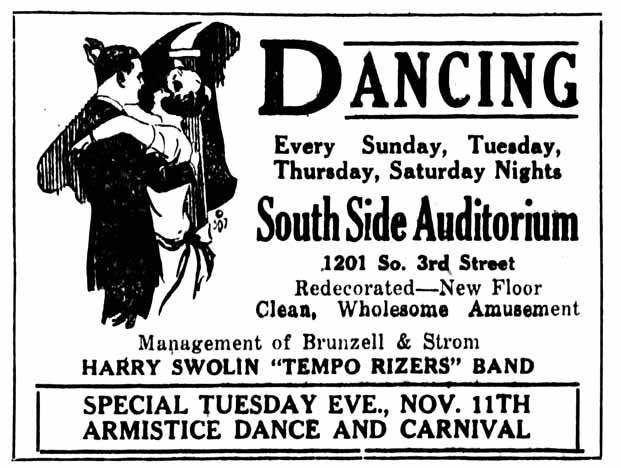
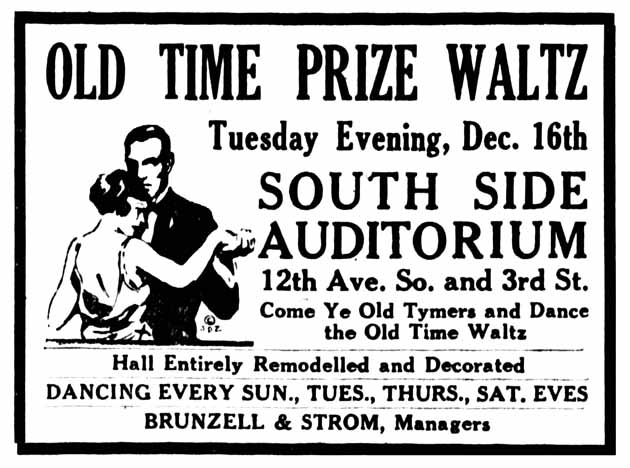
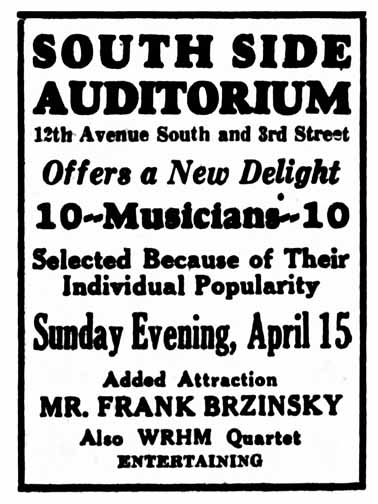
17th ANNIVERSARY
An article from 1928 states that the SSA will celebrate its 17th Anniversary with a special program. Still proprietors after 17 years were “Bunzell and Strom.” Nobody can spell. Correct me if I’m wrong, but that brings the beginnings of the SSA to 1911, and we know that it was in operation going back to at least 1909. Maybe they mean when Strom and Brinzell/Brunzell/Bunzell took over management. (Minneapolis Star, April 14, 1928)
TROUBLE BREWING
The dance hall license committee balked at renewing the license for the SSA in May 1928 “because of complaints made against it.” It was eventually renewed.
January 1, 1929, opened with ads in the Minneapolis Tribune for “American” music on Sundays, and music by Herbert Brunzell’s Orchestra on Thursdays and Saturdays.
In between a lot of Scandinavian dances, there were:
The Night Owls, Colored musicians from Omaha, were scheduled to play at the SSA on May 5, 1929.
The Dixie Ramblers Band, also from Omaha, came to the SSA on May 19, 1929.
THE DEPRESSION
There is a gap between September 11, 1930 and December 1931. The three ads in 1931 are “Bargain Dances,” admission 10 cents, playing old-time American music, to introduce you to the beautiful SSA.
Hans Strom was evidently out, as his name is seen as the manager of the Minneapolis Coliseum in 1931. He died in June 1950 at the age of 69.
THE END IS NEAR
Ads above give admission prices of 55 cents to 75 cents in the early 1920s, but the coupon below from 1932 represents a cut in cost, undoubtedly a factor of the Depression and an increased competition for customers among all the ballrooms in town.
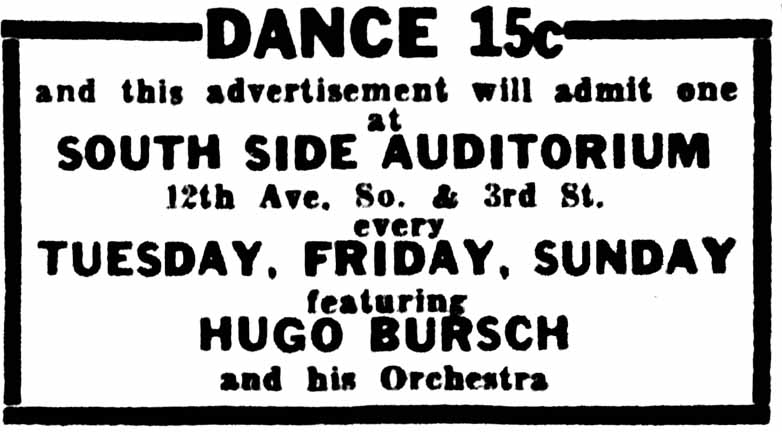
EVERYONE WELCOME
The SSA was a meeting place for all sorts of groups, including many union and political groups in the politically-charged days when many trades were unionizing, and during the Depression years when Communism started to look like a good alternative to some people. On November 4, 1934, a Communist rally was held at the SSA before the 1934 election. This is interesting because at the Labor Temple, there was some picking and choosing about what groups could rent the space. Apparently there were no judgements here.
Below you can see that the cost has dropped from 15 cents to 10 cents, reducing income even further in an attempt to draw customers.
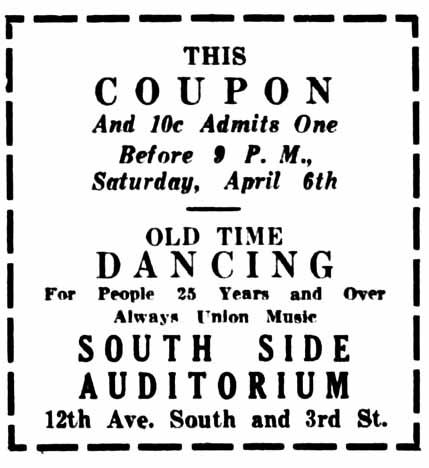
TICKET TAKER SLUGGED
There must have been a dance on October 4, 1936, because the ticket taker got slugged (their word, not mine) by a guy who was refused admittance. You read it here. (Minneapolis Tribune, October 6, 1936)
The Bakers Union had their annual Thanksgiving Eve dance at the SSA on November 25, 1936.
END OF THE SOUTH SIDE AUDITORIUM
It appears that the hall was no longer used after 1939. Competition among the many other ballrooms was stiff, and the Depression took disposable income out of people’s pockets. The last ad I found was this one:
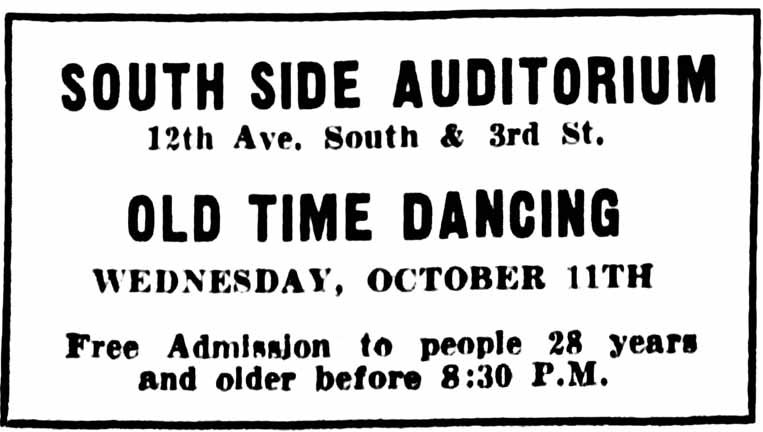
In the 1940s the building was used by a surplus company. Finally in July 1967, the building was taken by eminent domain for the construction of some crazy loop at 35W and 4th Street.


